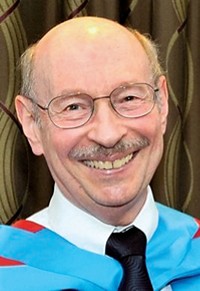Advertisement
Grab your lab coat. Let's get started
Welcome!
Welcome!
Create an account below to get 6 C&EN articles per month, receive newsletters and more - all free.
It seems this is your first time logging in online. Please enter the following information to continue.
As an ACS member you automatically get access to this site. All we need is few more details to create your reading experience.
Not you? Sign in with a different account.
Not you? Sign in with a different account.
ERROR 1
ERROR 1
ERROR 2
ERROR 2
ERROR 2
ERROR 2
ERROR 2
Password and Confirm password must match.
If you have an ACS member number, please enter it here so we can link this account to your membership. (optional)
ERROR 2
ACS values your privacy. By submitting your information, you are gaining access to C&EN and subscribing to our weekly newsletter. We use the information you provide to make your reading experience better, and we will never sell your data to third party members.
People
Frank H. Field & Joe L. Franklin Award for Outstanding Achievement in Mass Spectrometry
January 29, 2007
| A version of this story appeared in
Volume 85, Issue 5
Sponsored by Waters Corp.
Like many chemists of a certain age, Jean H. Futrell first discovered a love of chemistry when he was given a chemistry set as a Christmas present.
Now, at the age of 73, Futrell is Senior Battelle Fellow and science adviser in the Office of the Chief Research Officer at Pacific Northwest National Laboratory. He served as the first director of the Environmental Molecular Sciences Laboratory (EMSL) from 1998 to 2002 and is now the director emeritus.
While his interest in chemistry dates back to that chemistry set, Futrell first became interested in mass spectrometry in graduate school. "Although I never consciously set it as a goal, I am sure that my interest in using mass spectrometry methods to investigate elementary reactions of ions is traceable to my graduate student days, where I first learned about these marvelous machines at Lawrence Berkeley Laboratory," he says. No university chemistry departments had mass spectrometers in those days, Futrell says, and it was several years before he had hands-on access to one.
In graduate school, Futrell studied the radiation chemistry of dichloroethylenes. It was of great interest to scientists investigating the chemical effects of ionizing radiation that quantitative rate constants for ion reactions could be measured by mass spectrometry. In 1958, he received his Ph.D. in physical chemistry from the University of California, Berkeley.
He briefly worked as a radiation chemist at the Humble Oil & Refining Co. (now ExxonMobil) Research Center in Baytown, Texas. Following a stint as an officer in the U.S. Air Force, he worked from 1961 to 1967 as a civilian scientist at Aerospace Research Laboratories at Wright-Patterson Air Force Base. In 1967, he became a chemistry professor at the University of Utah. He moved to the University of Delaware in 1986.
Futrell counts tandem mass spectrometry as his most significant contribution to mass spectrometry. He connected multiple mass analyzers in series, separated by reaction cells, first with a five-sector magnetic sector and later with triple quadrupoles and other types of mass analyzers. "My objective at the time was investigation of reaction mechanisms and dynamics of low-energy, ion-molecule reactions," he says. "Analytical applications were developed for the most part by other scientists."
In retrospect, he realizes that he overlooked the enormous commercial potential for tandem mass spectrometry in analytical chemistry. "Patenting the concept would have been a great idea," he says.
R. Graham Cooks, Henry Bohn Hass Distinguished Professor in the department of chemistry at Purdue University, describes Futrell's career as one of "groundbreaking science stretching from the 1960s through the 2000s."
"To a remarkable degree, Jean's research interests have been driven by attempts to understand, in a quantitative way, fundamental ionic phenomena," Cooks says. "In pursuing these endeavors, he has shown himself to be one of the most gifted of instrumentalists and has achieved deep insights into the complex behavior of simple and more complex ions."
The award address will be presented before the Division of Physical Chemistry.






Join the conversation
Contact the reporter
Submit a Letter to the Editor for publication
Engage with us on Twitter